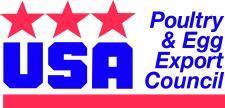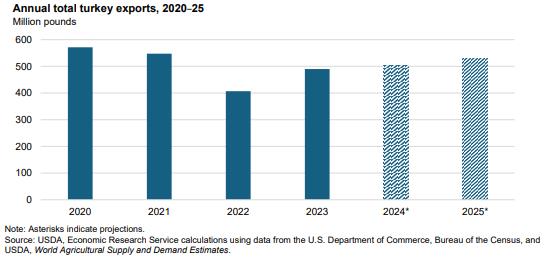 U.S. Broiler and Turkey Exports, January-August 2024.
U.S. Broiler and Turkey Exports, January-August 2024.
OVERVIEW
Total exports of bone-in broiler parts and feet during January-August 2024 attained 2,170,745 metric tons, 11.2 percent lower than in January-July 2023 (2,170,745 metric tons). Total value of broiler exports decreased by 4.5 percent to $3,034 million ($3,176 million).
Total export volume of turkey products during January-August 2024 attained 144,754 metric tons, 8.2 percent more than in January-August 2023 (133,729 metric tons). Total value of turkey exports increased by 9.7 percent to $431 million ($393 million).
Unit price for the broiler industry is constrained by the fact that leg quarters comprise over 96 percent of broiler meat exports by volume (excluding feet). From the first quarter of 2021 through 2022, the value of leg quarters increased in unit value consistent with international demand followed by a decline in 2023. Leg quarters represent a relatively low-value undifferentiated commodity lacking in pricing power. Exporters of commodities are subjected to competition from domestic production in importing nations. Generic products such as leg quarters are vulnerable to trade disputes and embargos based on real or contrived disease restrictions. To increase sales volume and value the U.S. industry will have to become more customer-centric offering value-added presentations with attributes required by importers. Whether this will increase margins is questionable given the by-product contribution of leg quarters. A more profitable strategy for the U.S. industry would be to develop products using dark meat to compete with and displace pork and beef in the domestic retail and institutional markets.
HPAI is now accepted to be a panornitic affecting the poultry meat industries of six continents with seasonal and sporadic outbreaks. The incidence rate and location of cases in the U.S. limits eligibility for export depending on restrictions imposed by importing nations
Ongoing outbreaks of African swine fever in China and Southeast Asia from early 2019 and Europe from 2010 onwards reduced the availability of pork. In addition, disruptions in chicken production and logistics due to COVID restrictions decreased availability of protein with international repercussions on trade in chicken and pork. The demand for pork imports to China has diminished with restoration of domestic hog production to the extent of overproduction. Mild oversupply is evident in the white-feathered broiler sector with implications for exports other than feet extending into 2024.
EXPORT VOLUMES AND PRICES FOR BROILER MEAT
 During January-August 2024 the National Chicken Council (NCC), citing USDA-FAS data, documented exports of 2,114,048 metric tons of chicken parts and other forms (whole and prepared), down 10.7 percent from January-August 2023. Exports were valued at $3,124 million with a weighted average unit value of $1,422 per metric ton.
During January-August 2024 the National Chicken Council (NCC), citing USDA-FAS data, documented exports of 2,114,048 metric tons of chicken parts and other forms (whole and prepared), down 10.7 percent from January-August 2023. Exports were valued at $3,124 million with a weighted average unit value of $1,422 per metric ton.
The NCC breakdown of chicken exports for January-August 2024 by proportion and unit price for each category compared with the corresponding months in 2023 (with the unit price in parentheses) comprised:-
- Chicken parts (excluding feet) 2%; Unit value $1,327 per metric ton ($1,246)
- Prepared chicken 2%; Unit value $6,132 per metric ton ($4,377)
- Whole chicken 6%; Unit value $1,673 per metric ton ($1,688)
- Composite Total 0%; Av. value $1,422 per metric ton ($1,311)
The following table prepared from USDA data circulated by the USAPEEC, compares values for poultry meat exports during January-August 2024 compared with the corresponding months of 2023:-
|
PRODUCT
|
Jan.-Aug. 2023
|
Jan.-Aug. 2024
|
DIFFERENCE
|
|
Broiler Meat & Feet
|
|
|
|
|
Volume (metric tons)
|
2,445,553
|
2,170,745
|
-274,808 (-11.2%)
|
|
Value ($ millions)
|
3,176
|
3,034
|
-142 (-4.5%)
|
|
Unit value ($/m. ton)
|
1,299
|
1,395
|
+96 (+7.4%)
|
|
Turkey Meat
|
|
|
|
|
Volume (metric tons)
|
133,729
|
144,754
|
+11,025 (+8.2%)
|
|
Value ($ millions)
|
393
|
431
|
+38 (+9.7%)
|
|
Unit value ($/m. ton)
|
2,939
|
2,978
|
-39 (-1.3%)
|
COMPARISON OF U.S. CHICKEN AND TURKEY EXPORTS JANUARY-August 2024 COMPARED TO 2023
 BROILER EXPORTS
BROILER EXPORTS
Total broiler parts, predominantly leg quarters but including feet, exported during January-August 2024 compared with the corresponding months in 2023 declined by 11.2 percent in volume and 4.5 percent in value. Unit value was 7.4 percent higher to $1,395 per metric ton.
During 2023 exports attained 3,635,178 metric tons valued at $4,739 million, down 4.2 percent in volume and down 9.2 percent in value compared to 2022. Unit value was down 9.5 percent to $1,284 per metric ton
Broiler imports in 2024 are projected to attain 63,600 metric tons (140 million lbs.) rising to 72,000 metric tons (160,000 million lbs.) in 2025
The top five importers of broiler meat represented 46.1 percent of shipments during January-August 2024. The top ten importers comprised 64.7 percent of the total volume reflecting concentration among the significant importing nations but with a decline in the importance of China.
During January-August 2024 Mexico was the first-ranked importer by volume and value with 482,182 metric tons representing 22.2 percent of export volume up 0.7 percent from the first half of 2023. Value at $620 million was 20.4 percent of the total for exported broiler products during January-August 2024 and up 15.9 percent from 2023, but with a 15.0 percent increase in unit price to $1,285 per metric ton. During August 2024 volume was down 2.4 percent to 61,120 metric tons and value was higher by 15.0 percent from August 2023 to $81.5 million.
 |
Cuba was the 2nd-ranked importer based on volume during January-August 2024 with 168,370 metric tons representing 7.8 percent of the eight-month total, valued at $201.5 million. Exports were down 14.5 percent in volume and 2.1 percent in value compared to January-August 2023. Unit price was $1,197 per metric ton. During August 2024 Cuba was 2nd-ranked with imports down 35.3 percent in volume to 22,690 metric tons and down 25.1 percent in value to $27.7 compared to August 2023 with a unit price of $1,221 per metric ton.
Taiwan was 3rd ranked as an importer during January-August 2024 with 131,229 metric tons, representing 6.1 percent of the eighth-month volume valued at $159.3 million, down 35.3 percent and 40.1 percent in volume and value respectively, compared to the previous year. Unit price was $1,214 per metric ton. During August Taiwan was ranked 6th in volume with exports down 24.7 percent to 12,885 metric tons and down 30.3 percent in value to $15.4 compared to August 2023.
The Philippines ranked 4th among importers with 108,502 metric tons valued at $119.1 million and at a unit price of $1,078 per ton over the first eight months of 2024. Volume and value were respectively higher by 7.1 and 8.5 percent compared to January to August 2023. During August the Philippines ranked third in volume with 20,416 metric tons representing 7.6 and 6.3 percent of monthly volume and value of broiler exports respectively. The increase in volume to the Philippines is attributed to the reduced availability of pork due to an ongoing epizootic of African swine fever.
During January-July 2024 exports to China, 5th-ranked by volume and 2nd ranked by value represented 5.0 percent by volume and 8.1 percent by value of shipments. Exports were down 64.4 percent in volume to 108,502 metric tons and down 51.9 percent in value to $247 million compared to January-August 2023. Unit price was $2,276 per metric ton up 26.1 percent. During August 2024 China ranked 9th among importers based on volume, receiving 8,845 metric tons down 68.4 percent from August 2023. Exports in August 2024 were valued at $33.9 million down 38.3 percent with a unit price of $3,833 per metric ton, up 100.0 percent and confirming the predominance of feet in relation to other products.
During 2023, 405,313 metric tons of U.S. broiler products were shipped to China, valued at $711,172 with an average unit value of $1,755 per metric ton. A breakdown of product categories and prices was provided by USAPEEC. Paws and feet represented 68.5 percent of volume and 73.1 percent of value with a unit price of $1,871 per metric ton. Legs and leg quarters comprising 22.6 percent of volume and 12.8 percent of value were priced at $990 per metric ton below the $1,302 average for all U.S. exports excluding China. Wings comprised 4.6 percent of volume and 5.7 percent of value with a unit price of $2,190 per metric ton. All other poultry products (including 4 tons of duck meat) amounting to 4.2 percent of volume and 8.4 percent of value attained an average unit price of $3,485 per metric ton
During January-August 2024 exports to Hong Kong, 10th ranked by volume, but 7th by value, increased by 104.0 percent in volume to 61,339 metric tons and 83.9 percent in value to $94.2 million with a unit price of $1,528 per metric ton. In 2022 and 2023 unit prices were $1,834 and $1,671 per metric ton respectively. Accordingly consignments are presumed to comprise a high proportion of feet with assumed transshipment to the Mainland as in past years.
During January-August 2024 export volume to 6th-ranked Canada was almost unchanged from 2023 at 99,352 metric tons valued at $302.6 million.
Nations gaining in volume compared to the corresponding period in 2023 (with the percentage change indicated) in descending order of volume with ranking indicated by numeral were:-
- Mexico, (+0.7%); 4. Philippines, (+7%); 6. Canada, (+0.7%); 8. Viet Nam, (+22%); 9. Angola, (+15%); 10. Hong-Kong, (+104%); 11.UAE, (+55%); 13, Ghana, (+23%); 14. Dominican Republic, (+15%)
Losses during January-August 2024 offset the gains in exports with declines for:-
- Cuba, (-15%); 3. Taiwan, (-35%); 5. China, (-64%); 7. Guatemala, (-2%); 12. Georgia, (-17%); 15. Haiti, (-23%); 17. Colombia, (-14%) and 18. Congo–Braz., (-49%).
TURKEY EXPORTS
The volume of turkey meat exported during January-August 2024 increased by 8.2 percent to 144,754 metric tons from January-August 2023 and value was 9.7 percent higher to $431 million compared to January-August 2023. Average unit value was 1.3 percent lower to $2,978 per metric ton.
Imports of turkey products will attain 15,000 metric tons (33 million lbs) in 2024 and a similar value in 2025.
For the entire year of 2023 export volume increased by 20.2 percent to 221,098 metric tons compared to 2022 and value fell by 2.0 percent to $620 million reflecting an 18.5 percent decrease in unit value to $2,829 per metric ton.
Mexico was the dominant importer of turkey products during January-August 2024 with 110,265 metric tons representing 76.2 percent of total volume of 144,754 metric tons. Value at $320.6 million was 74.4 percent of the total. Volume was 19.9 percent higher and value was 16.5 percent higher than for January-August 2023. Unit value was down 2.8 percent to $2,905 per metric ton. During August Mexico imported 15,393 metric tons valued at $45 million, down 4.5 percent in volume but up 18.8 percent in value.
Imports by the nations of the Caribbean (10,318 metric tons); Canada (3,749); Central America, (5,801), and East Asia (3,571) collectively comprised 23,499 metric tons of turkey products in January-August 2024 representing 16.2 percent of volume and 19.1 percent of total export value with the combined regions amounting to $82.1 million. Unit price was $3,493 per metric ton.
During January-August 2024 nations increasing volumes of purchases, albeit over a small base, compared to the corresponding months in 2023 with ranking comprised:-
- Mexico, (+20%); 4. Dominican Republic, (+33%);
Nations reducing volume of imports over January-August included:-
- Canada, (-29%) and 3. Jamaica, (-25%) and 5. Windward and Leeward Islands, (-54%).
PROJECTION FOR 2024 and 2025
The October 18th 2024 Livestock, Dairy and Poultry Outlook Report, updated 2024 exports of broiler products upwards to 3.055 million metric tons (6,721 million lbs.). This value represents 14.3 percent of the projected production of 21.402 million metric tons (47,084 million lb.) of broiler RTC by the U.S. industry.
For 2025 exports of broiler products were forecast at 3.095 million metric tons (6,810 million lbs.), equivalent to 14.2 percent of forecast annual production of 21.738 million metric tons (47,825 million lbs.)
Projected export of turkey products in 2024 will be 229,090 metric tons, (504 million lbs.) or 9.9 percent of annual production of 2.323 million metric tons (5,110 million lbs.).
For 2025 export of turkey products in 2025 is forecast at 240,909 metric tons (530 million lbs.) equivalent to 10.3 percent of forecast annual production of 2.347 million metric tons (5,165 million lbs.)
It is important to recognize that exports of chicken and turkey meat products to our USMCA partners amounted to $1,264 million in 2021, $1,647 million during 2022, $1,696 in 2023 and $1,257 million over the first eight-months of 2024. It will be necessary for all three parties to the USMCA to respect the terms of the agreement since punitive action against Mexico or Canada on issues unrelated to poultry products will result in reciprocal action by our trading partners to the possible detriment of U.S. agro-industries. This is especially important as Mexico has elected a new Presidenta and a change in the Government of Canada is anticipated.
The emergence of H5N1strain avian influenza virus with a Eurasian genome in migratory waterfowl in all four Flyways of the U.S. during 2022 was responsible for sporadic outbreaks of avian influenza in backyard flocks and serious commercial losses in egg-producing complexes and turkey flocks but to a lesser extent in broilers. The probability of additional extensive outbreaks of HPAI over succeeding weeks appears less likely as spring migration of waterfowl has concluded. Incident cases in 2024 comprised 1.3 million commercial-level meat turkeys and 70,000 breeders through August. Additional outbreaks affecting egg-production and turkey flocks occurred during October and additional incident cases will be a function of shedding by migratory and domestic birds and possibly free-living mammals or indirectly from dairy herds. The extent of protection of commercial flocks at present relies on the intensity and efficiency of biosecurity including wild-bird laser repelling installations, representing investment in structural improvements and operational procedures. These measures are apparently inadequate to provide absolute protection, suggesting the need for preventive vaccination in high-risk areas for egg-producing, breeder and turkey flocks.
The application of restricted county-wide embargos following the limited and regional cases of HPAI in broilers with restoration of eligibility 28 days after decontamination has supported export volume for the U.S. broiler industry. Exports of turkey products were more constrained with plants processing turkeys in Minnesota, the Dakotas, Wisconsin and Iowa impacted. Most nations have now lifted embargos that were previously placed on entire states or counties following outbreaks in the1st and 2nd quarters of 2024 as the WOAH mandated post-decontamination period has expired. The challenge will be to gain acceptance for vaccination based on intensive surveillance. It is now accepted that H5N1 HPAI is panornitic in distribution among commercial and migratory birds across six continents. The infection is now seasonally or regionally endemic in many nations with intensive poultry production, suggesting that vaccination will have to be accepted among trading partners as an adjunct to control measures in accordance with WOAH policy.
The live-bird market system supplying metropolitan areas, the presence of numerous backyard flocks, fighting cocks and commercial laying hens allowed outside access, potentially in contact with migratory and now some resident bird species, all represent an ongoing danger to the entire U.S. commercial industry. The live-bird segments of U.S. poultry production represent a risk to the export eligibility of the broiler and turkey industries notwithstanding compartmentalization for breeders and regionalization to counties or states for commercial production.